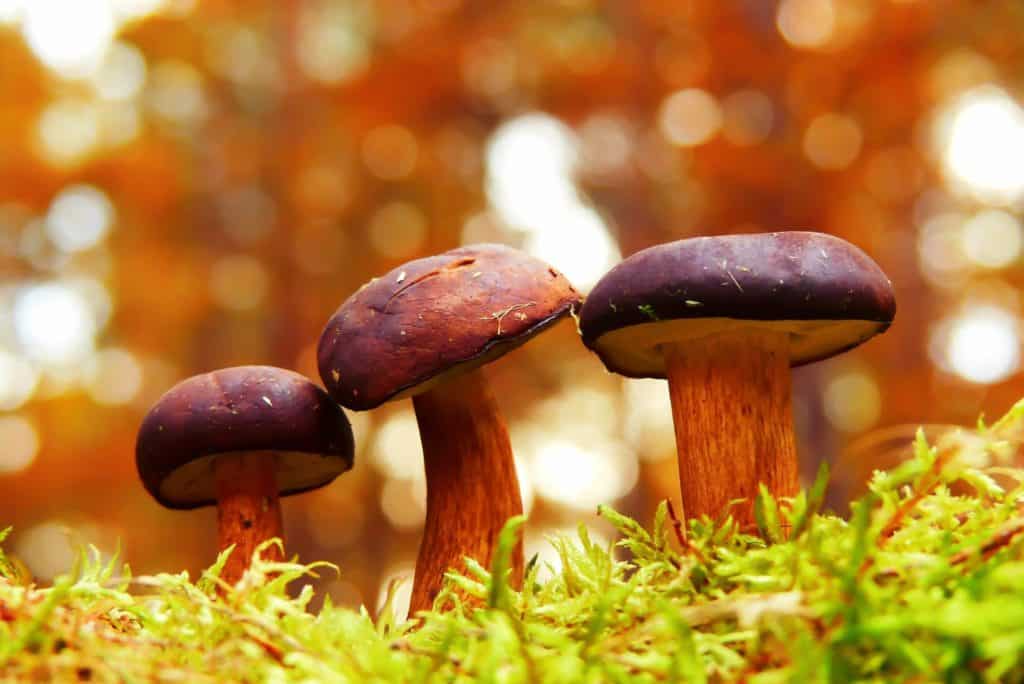
Alexis Guerin-Laguette
MSc (Plant physiology), PhD (Agronomy and Mycorrhizal symbiosis)
Note — The article was checked and updated April 2023.
Mushrooms and fungi are terms that are sometimes used interchangeably. However, not all fungi are mushrooms, whereas all mushrooms are considered fungi. Today there are over 10,000 known types of mushrooms and over 150,000 known types of fungi. Many more are to be discovered and classified.
Based on the studies so far, the researchers have recognized that the main health benefits of mushrooms and fungi are:
- providing antioxidants
- immunomodulating
- anti-inflammatory
- anti-tumor
- supporting gut health
- lowering cholesterol
- maintaining healthy blood pressure
- managing type 2 diabetes
- boosting fetal health
- boosting memory
- preventing neurological illnesses
We will be discussing other areas such as nutritional content and providing data for vitamins, minerals, and protein values. But before we go any further, first we need to understand what the difference is between mushrooms and fungi.
What is the difference between mushrooms and fungi?
A mushroom is the fleshy, spore-bearing fruiting body of a fungus, like an apple is the fruit of an apple tree. We rarely get to see the main body of a fungus, which, in mycology jargon, is called “mycelium”.
Mushrooms are short-lived, like fruits, but the mycelium that produced them is around almost permanently, colonising soil or substrate made of organic matter.
A mycelium is a network of fine fungal threads called “hyphae” – made of linear series of end-to-end fungal cells – invisible to the naked eye unless hyphae start clumping together.
Fungi are a large group of organisms that includes yeasts, moulds, and mushrooms. They are a separate kingdom of life – neither plant nor animal. However, like animals, they don’t photosynthesize and feed on organic compounds.
There are between 2 to 4 million species of fungi on earth, of which only about 150,000 have been described.
Fungi can take all sorts of shapes and are amazingly diverse. There are many kinds of fungi in the world.
Fungi can be divided into three groups based on their lifestyles:
- Saprotrophic (decomposers)
- Symbiotic – Parasitic (pathogenic)
- Symbiotic – Mutualistic (beneficial)
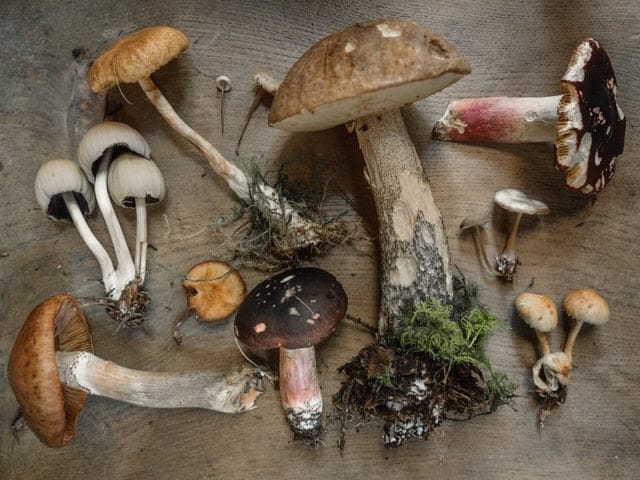
Saprotrophic fungi are the primary decomposers of litter in ecosystems, growing on dead wood, plant debris, or soil organic matter. Some fungi are the only organisms who can degrade lignin, a complex substance found in wood, thanks to their hyphal network.
The button mushroom, oyster, or shiitake mushrooms are examples of saprotrophic fungi whose mycelium grows on organic matter (we eat their fruiting bodies).
Symbiosis means that two organisms live together in intimate association. The relationship may favor one of them (parasitism) or benefit both (mutualism).
Parasitic fungi invade their hosts (plants or animals), live on them, and eventually kill them. Fungi can be pathogens of plants (trees, cereals) and animals. For example, the famous caterpillar fungus (Ophiocordyceps sinensis) is a parasite of insects. Humans, too, may be seriously infected by microscopic fungi if the symptoms are not treated on time, such as aspergillosis of the lungs.
Mushroom is the fleshy, spore-bearing fruiting body of a fungus
Mutualistic fungi live together with other creatures in a reciprocally beneficial way. One of the best examples is the mycorrhizal fungi who colonize roots of suitable plants by forming mycorrhizae (from Greek ‘mycor-rhiza’ = ‘fungus root’).
Mycorrhizal fungi get sugar from the plants, who make sugar from carbon dioxide and water by photosynthesis, and fungi provide plants with water and nutrients from the soil.
The famous truffles or forest mushrooms such as porcini, chanterelles (see the image below) and milk caps are good examples of mycorrhizal fungi. A few fungi live with insects in a mutualistic way, such as Termitomyces with termites.
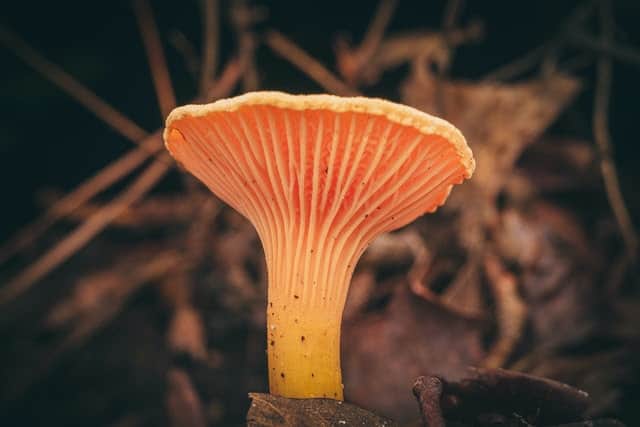
Based on their fruiting habits, fungi are divided into two kinds:
- Epigeous fungi produce above ground fruiting-bodies, such as the button mushroom. Epigeous fungi can be all sorts of fungi: mutualistic, saprotrophic or parasitic.
- Hypogeous fungi produce underground fruiting bodies, such as truffles. They are mostly mycorrhizal. There are a few saprotrophic species that form closed fruiting bodies, sometimes buried under leaves.
What are the health benefits of mushrooms and fungi?
Mushrooms are delicious and nutritious foods, and have been consumed by humans for millennia in almost every area of the world. They provide a wide range of taste, color, flavor, and connoisseurs will never miss an opportunity to cook with their favorites.
Because of their singular position in the tree of life and their various components, mushrooms and fungi in general have a great potential for health-promoting functions. The nutritious qualities, health benefits, and simply happiness brought by mushrooms are described in the sections below.
11 Health benefits of medicinal mushrooms present in low and high molecular weight compounds are:
- antioxidants
- immunomodulating
- anti inflammatory
- anti-tumor
- supports gut health
- lowers cholesterol
- maintains healthy blood pressure
- helps managing type 2 diabetes
- boosts fetal health
- boosts memory
- preventing neurological illnesses
RELATED — Diabetes: Early Signs, Causes, Types and Treatment
Medicinal mushrooms
- lowering blood lipids
- protecting liver
- antioxidant, antibacterial, and anti-inflammatory activities.[1]
- Turkey tail (Trametes versicolor)
- Chaga (Inonotus obliquus)
- Caterpillar fungus (Ophiocordyceps sinensis)
- Lion’s mane (Hieracium erinaceus).
Mushrooms and fungi have a great potential for health-promoting functions
Magic mushrooms have been gaining strong interest lately from researchers and psychiatrists, who are considering using some of the substances they contain to treat brain and behavioral disorders, e.g., antidepressant effects of psilocybin-assisted therapy in patients with major depressive disorders.[2]
RELATED — Introduction to: Depression
Happiness (through cooking)
This is the last but not the least important health benefit of edible fungi! Mushrooms (decomposers or symbiotic) and truffles are not only good for us but also provide joy through the different aroma, colour, and texture that they confer to dishes.
RELATED — for some great recipes see our Recipes page..
Truffles are the most famous fungal delicacies worldwide but in many of the so-called ‘mycophilic’ countries, local populations have developed over the millennia a fine knowledge of hundreds of wild edible fungi.
Local populations know how to safely choose or prepare wild edible fungi and enjoy them. Edible mycorrhizal fungi of the world have been reviewed recently.[3]
Nutritional value of mushrooms
Mushrooms produce multiple bioactive compounds. Many of these bioactive compounds can be a source of natural antioxidative, antitumor, lipid-lowering, and immunomodulatory agents. Their health attributes have been reviewed by Cheung (2010) and Zhang et al. (2021), while Pérez-Moreno & Martínez-Reyes (2014) focused on the health properties of edible mycorrhizal mushrooms.
Bioactive compounds
Bioactive compounds include many different types of molecules, such as:
- Polysaccharides (polymeric carbohydrates, sort of complex sugars comparable to but different from the starch found in plants)
- Dietary fibers
- Proteins
- Essential amino acids
- Vitamins
- Minerals
Polysaccharides
Edible fungi have polysaccharides such as β-glucans, made of linked β-D-glucose molecules. Chitin is another polysaccharide present in edible fungi that is found also in crustaceans and insects. Fungal polysaccharides can offer various health benefits acting as antioxidants, immunostimulant, hypoglycaemic, or as dietary fibers since they are not digestible.
Fibers are particularly high in some species, e.g., wood ear (Auricularia auricula-judae). The fungal polysaccharides in shiitake (Lentinula edodes) are helpful for immunity recovery after operation of the cancer patient. The fungal polysaccharides from lion’s mane mushroom (Hericium erinaceus) can be used for treatment of stomach problems.
Proteins
Edible fungi are richer in proteins and amino acids than most vegetables, with about 19 to 40% of their dry weight being made of proteins.[1]
Edible fungi can therefore be a complementary source of proteins in association with traditional sources (meat, fish) that can then be consumed in lesser quantities for both our benefit and that of the planet.
RELATED — Diet and the Brain: Proteins (cognition and brain performance)
It is well-known that producing animal proteins mobilizes abundant natural resources and is not always sustainable. Protein from mushrooms will not cause health problems such as hypertension, hyperlipidaemia, and high cholesterol, which is common with consumption of animal proteins.
Top 10 mushrooms with the highest protein content are listed in the table below.[4]
Type of mushroom | Protein Amount in grams (per 100/g) |
Porcini | 7.39g |
Oyster mushrooms | 3g – 5g |
Portobello (mature button mushroom) | 4.5g |
White button mushroom | 3.2g |
Morel | 3.1g |
Enoki | 2.6g |
Cremini (brown button mushroom) | 2.6g |
Shitake | 2.3g |
Maitake | 1.9g |
Chanterelle | 1.7g |
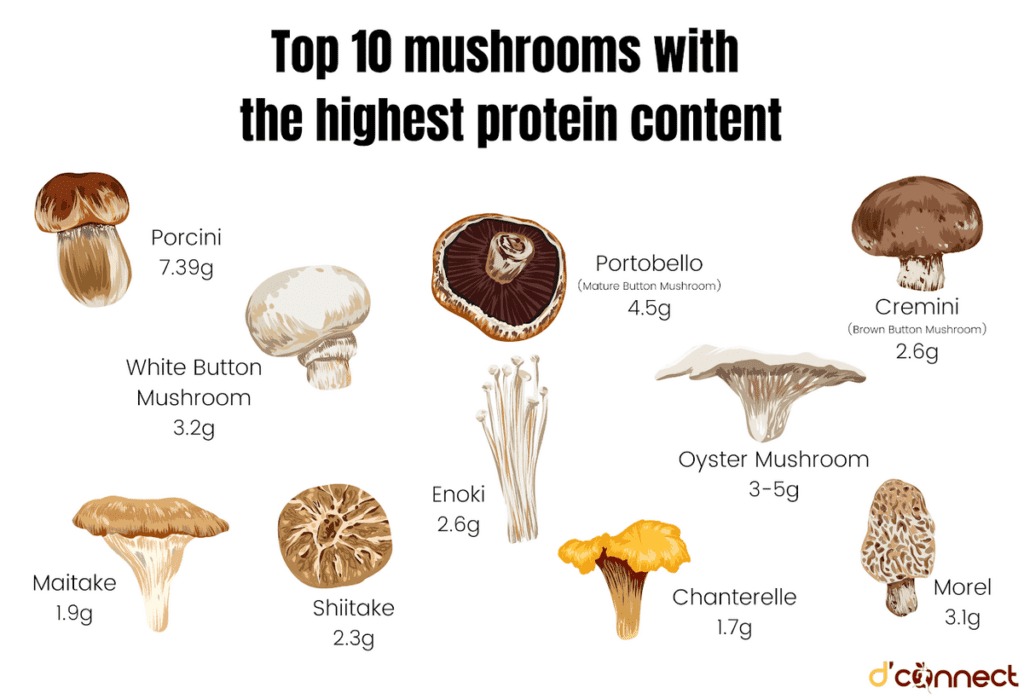
Essential amino acids
Mushroom proteins are relatively rich in essential amino acids, which humans cannot synthesize. These essential amino acids are:
- histidine
- isoleucine
- leucine
- lysine
- methionine
- phenylalanine
- threonine
- tryptophan
- valine.[5]
RELATED — What are Amino Acids and what is their role in keeping us healthy?
Vitamins
Cultivated edible fungi have been shown to be a good source of vitamins, especially vitamin B2, B1, B12, C, and D. The riboflavin (vitamin B2) content in mushrooms is higher than generally found in vegetables, and some varieties of button mushroom (Agaricus bisporus) have concentrations as high as in eggs and cheese.
Cultivated mushrooms are poor in vitamin D but have high levels of provitamin D that can be converted into vitamin D in the presence of sunlight. The vitamin content of wild mushrooms is possibly interesting too but understudied.[5]
In the table below is the vitamin content of White button mushrooms (left) and Portobello mushrooms (right).[6]
Vitamins | unites | Average | SD | Average | SD |
μg | 24.4 | 1.3 | 30.5 | 4.1 | |
Folate | μg | 14 | 1 | 19 | 3 |
mg | 6.73 | 0.40 | 6.14 | 0.23 | |
mg | 1.75 | 0.07 | 1.35 | 0.07 | |
mg | 0.56 | 0 | 0.50 | 0.06 | |
mg | 0.34 | 0.05 | 0.30 | 0.01 | |
mg | <1 | – | <1 | – | |
Vitamin D2 | iu | <20 | – | <20 | – |
Vitamin D3 | iu | 111 | 27 | 336 | 84 |
μg | 2.8 | 0.7 | 8.4 | 2.1 |
Minerals
Edible fungi are a good source of minerals (calcium, iron, potassium, phosphorus, magnesium) but also trace elements essential for the human body (zinc, copper). The genus Boletus (which porcini mushrooms belong to) is known for having higher concentrations of selenium than other fungi.
In the table below is the mineral content of White button mushrooms (left) and Portobello mushrooms (right).[6]
Minerals | unites | Average | SD | Average | SD |
mg | 0.33 | 0.02 | 0.33 | 0.05 | |
Phosphorus | mg | 104 | 4 | 109 | 4 |
Potassium | mg | 375 | 21 | 385 | 7 |
Selenium | μg | 25.5 | 0.7 | 23 | 1 |
Sodium | mg | 3.7 | 0.4 | 3.9 | 0.1 |
mg | 0.54 | 0.07 | 0.47 | 0.05 |
Important to mention is that fungi may also accumulate heavy metals and, although more research is required, precaution must be taken depending on fungal species and the environment in which they grow.
What New Zealand fungi and mushrooms should you try first?
Although the consumption of edible fungi in New Zealand is much limited in comparison with China, Japan, France, or Mexico, they are getting more popular and there is a wide range of mushrooms that Kiwis may consider including in their diet or enjoying for special occasions.
I would divide the mushroom categories as follows:
- native vs exotic
- decomposers vs symbiotic (mycorrhizal or pathogens)
- wild vs cultivated
Because New Zealand was occupied by humans only recently in comparison with many other territories on earth, we lack the millennial knowledge of local native fungi that populations have developed in many countries.
Māori people developed a knowledge of fungi of Aotearoa that they have transmitted orally to generations, including aspects pertaining to edible fungi. Unfortunately, some of this knowledge disappeared, but some persisted and has been reviewed and compiled by New Zealand mycologists.[7,8]
New Zealand native edible fungi are mostly decomposers or parasitic and only harvested from the wild, but there are recent initiatives to cultivate some of them.
Here are a few examples of New Zealand native wild edible fungi that may become also available cultivated:
- te hakeke (Auricularia cornea), a wood ear relative
- te harore (Armillaria novae-zelandiae), a honey mushroom relative
- Lentinula novae-zelandiae, a shiitake relative
- te tawaka (Cyclocybe parasitica), a Poplar mushroom relative
- te pekepekekiore (Hericium novae-zealandiae), a relative of the fungus icicle popular in Asia
- Pleurotus parsonsiae, an endemic oyster mushroom species
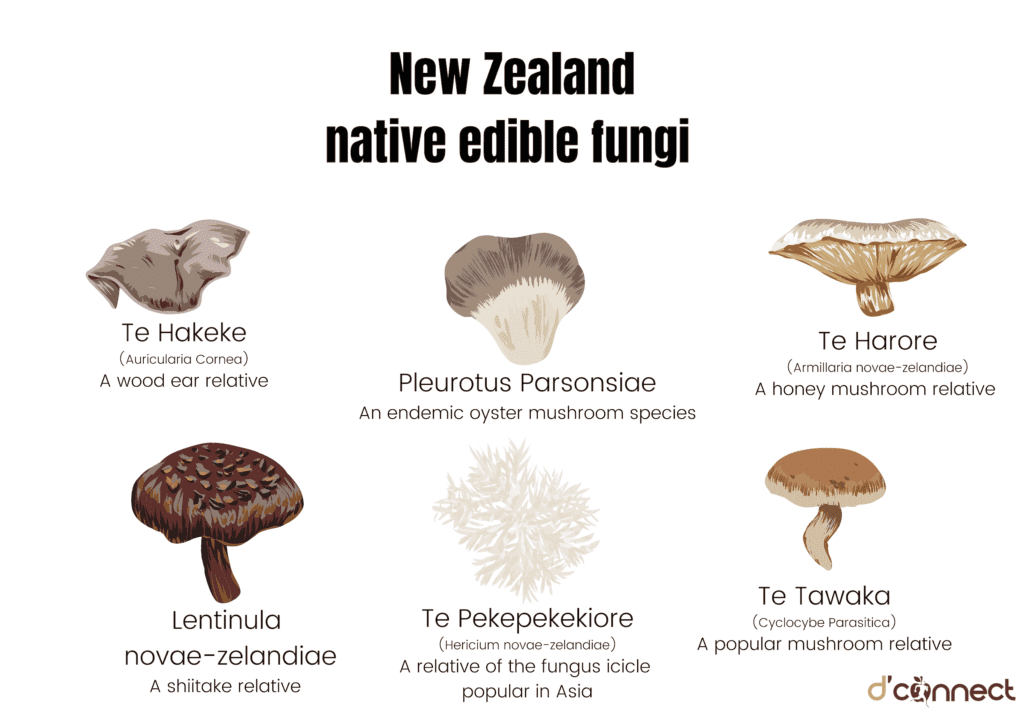
Exotic wild edible fungi are mostly decomposers but not only since you will read below that a few are mycorrhizal. The most common decomposer mushrooms are:
- wild versions of button mushrooms (Agaricus campestris, A. arvensis)
- fairy ring mushroom (Marasmius oreades)
- wood blewit (Lepista nuda)
- velvet shank (Flammulina velutipes), also known as enokitake in its cultivated version in Japan
There are several edible mycorrhizal mushrooms present in the wild, the most common being:
- the slippery jack (Suillus luteus)
- the birch bolete (Leccinum scabrum)
- the deceiver (Laccaria laccata)
The most famous and sought after is certainly porcini (Boletus edulis), now found in abundance in the South Island and in the south of the North Island. Below is the image of porcini mushrooms harvested from the Canterbury region.
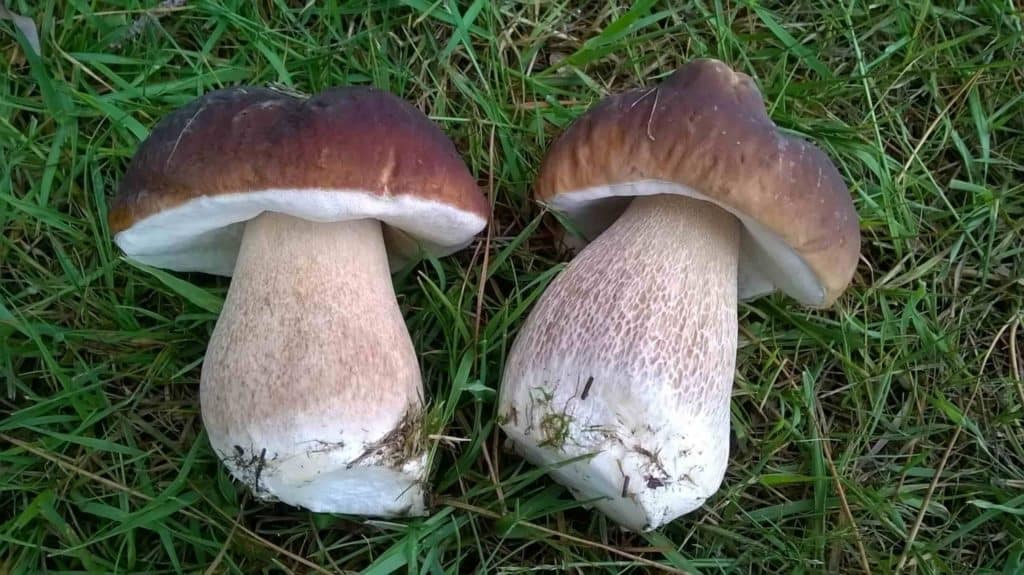
Famous morels, mostly decomposers, are also growing in New Zealand but are relatively rare and more work is required to describe which species are present. It seems that the black morel (Morchella importuna) is one of them.
Cultivated exotic fungi present on the market are still dominated by the button mushroom (Agaricus bisporus), but more varieties are becoming available, i.e., several species of oyster mushrooms (Pleurotus spp.), Asian shiitake (Lentinula edodes), enoki (F. velutipes), and the wine cap (Stropharia rugosoannulata).
Finally, since the mid-1980s, New Zealand has gained international recognition for its pioneering work cultivating exotic edible mycorrhizal fungi in tree orchards.[9]
Nowadays, several species of gourmet truffles and mushrooms are available in season directly from growers or from farmers’ markets and restaurants: The Périgord black truffle (Tuber melanosporum), the Bianchetto truffle (T. borchii), the Burgundy truffle (T. aestivum), the winter truffle (T. brumale), and the saffron milk cap mushroom (Lactarius deliciosus).[7,9]
The most famous and sought after mushroom in New Zealand is porcini (Boletus edulis)
In addition, it is possible to find value-added products made with NZ-grown edible mycorrhizal fungi (e.g., truffle salt, truffle butter, truffle beer, pickled saffron milk caps, etc.). You may be interested in consulting the New Zealand Truffle Association.
In the image below we can see Cassie with her Périgord black truffle harvest.
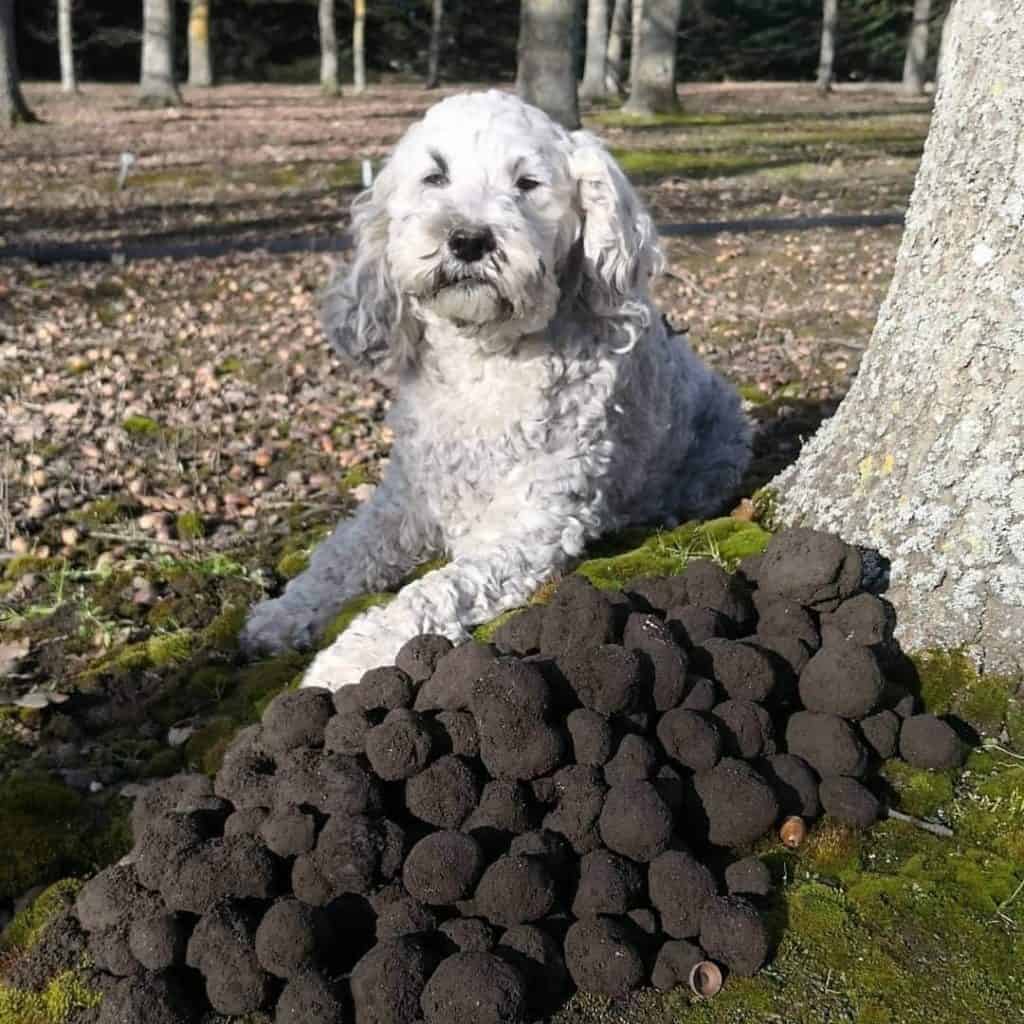
In conclusion, mushrooms are very precious resources as food, medicine, and nutraceuticals. Overall, they promote health, when included in a diet, for the synergistic effects of all their bioactive compounds. More research is required to better understand and use the health benefit potentials of fungi.
Many mushroom species have not yet been studied at all, suggesting that this area will continue to grow in future, providing many applications for humans as well as for the environment through the roles of fungi as decomposers, nutrient recyclers, or plants’ best friends, i.e., mycorrhizal fungi, also promoting carbon storage into soil.
Caution: It is of paramount importance to accurately identify edible wild mushrooms before consuming them. Accidents still happen when poisonous species are mistaken for edible ones. Furthermore, mushrooms are known to accumulate heavy metals and caution should be taken depending on where they have been growing.
Alexis Guerin-Laguette earned a PhD in Saffron Milk Cap in France. Since 2004, he has been a New Zealand-based expert in biology and cultivation of forest mushrooms and truffles. He has published over 30 peer-reviewed research articles and worked in Japan, Canada, and China.
In 2020, Alexis established Mycotree to pursue his work as a freelancer. Today, Alexis provides technical and consultancy services to growers, nurserymen, and investors.
References
(1) Zhang Y, Wang D, Chen Y, Liu T, Zhang S, Fan H, Liu H, Li Y. (2021). Healthy function and high valued utilization of edible fungi. Food Science and Human Wellness 10: 408-420. http://doi.org/10.1016/j.fshw.2021.04.003
(2) Davis AK, Barrett FS, May DG, Cosimano MP, Sepeda ND, Johnson MW, Finan PH, Griffiths RR. (2021). Effects of psilocybin-assisted therapy on major depressive disorder. A randomized clinical trial. JAMA Psychiatry 78: 481–489. https://doi.org/10.1001/jamapsychiatry.2020.3285
(3) Pérez-Moreno J, Guerin-Laguette A, Rinaldi AC, Yu FQ, Verbeken A, Hernández-Santiago F, Martínez-Reyes M. (2021). Edible mycorrhizal fungi of the world: What is their role in forest sustainability, food security, biocultural conservation and climate change? Plants People Planet 3: 471–490. https://doi.org/10.1002/ppp3.10199
(4) Altinify.com. These 9 mushrooms have the most protein. https://altinify.com/which-mushrooms-have-the-most-protein/
(5) Cheung PCK. (2010). The nutritional and health benefits of mushrooms. British Nutrition Foundation Nutrition Bulletin 35: 292–299. https://doi.org/10.1111/j.1467-3010.2010.01859.x
(6) Mussroomsite.com (2020). Portobello mushroom nutrition value and facts. https://mushroomsite.com/2020/07/29/portobello-mushroom-nutrition/
(7) Pérez-Moreno J, Guerin-Laguette A, Flores Arzú R, Yu FQ, Verbeken A. (2020). Setting the Scene. – Chapter 1. In: J. Pérez-Moreno, R. Flores-Arzú, A. Guerin-Laguette, F.Q. Yu (eds) Mushrooms, humans, and nature in a changing world: Perspectives from agricultural, ecological and social sciences. Springer Nature. https://doi.org/10.1007/978-3-030-37378-8_1
(8) Buchanan P, Stewart G, Jacob H. (2017). Ngā hekaheka o Aotearoa. A guide for teachers. Manaaki Whenua – Landcare Research.
(9) Guerin-Laguette A. 2021. Successes and challenges in the sustainable cultivation of edible mycorrhizal fungi – furthering the dream. Mycoscience 62:10-28. https://doi.org/10.47371/mycosci.2020.11.007
(10) Pérez-Moreno J & Martínez-Reyes M. (2014). Edible ectomycorrhizal mushrooms: biofactories for sustainable development. In: R. Guevara-Gonzalez, & I. Torres-Pacheco (Eds.), Biosystems engineering: biofactories for food production in the century XXI (pp. 151–233), Springer International Publishing Switzerland. https://doi.org/10.1007/978-3-319-03880-3_6

